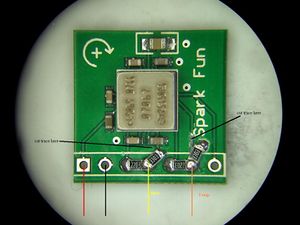Difference between revisions of "Gyroscopes"
Jump to navigation
Jump to search
| Line 6: | Line 6: | ||
== Sparkfun Breakout Board == | == Sparkfun Breakout Board == | ||
Example Gyroscope for MicroJet: this is the 150 degrees per second sensor from [http://www.sparkfun.com sparkfun]. The sensor is a 5 volt sensor while the tiny ADC is 3.3 volts. Using a resistor bridge of say 220k on 330k gives a nice 5 -> 3 volt conversion of the output. Ideally the gyro should be fed with very smooth stable 5V but as it | Example Gyroscope for MicroJet: this is the 150 degrees per second sensor from [http://www.sparkfun.com sparkfun]. The sensor is a 5 volt sensor while the tiny ADC is 3.3 volts. Using a resistor bridge of say 220k on 330k gives a nice 5 -> 3 volt conversion of the output. Ideally the gyro should be fed with very smooth stable 5V but as it will not be integrated but just used to help the slow thermopiles, the 5 Volts from the servos-receiver also work. | ||
Note the cut tracks - The 2.5v and ST2 pins are re-purposed as the midpoint in the resistor bridges as they are not needed for tiny. | |||
[[Image:ModifiedSparkfunCdw.jpg|thumb|Modified ADXR Sparkfun breakout board]] | [[Image:ModifiedSparkfunCdw.jpg|thumb|Modified ADXR Sparkfun breakout board]] | ||
Revision as of 13:26, 27 February 2008
Paparazzi ADXR Gyro board
Sparkfun Breakout Board
Example Gyroscope for MicroJet: this is the 150 degrees per second sensor from sparkfun. The sensor is a 5 volt sensor while the tiny ADC is 3.3 volts. Using a resistor bridge of say 220k on 330k gives a nice 5 -> 3 volt conversion of the output. Ideally the gyro should be fed with very smooth stable 5V but as it will not be integrated but just used to help the slow thermopiles, the 5 Volts from the servos-receiver also work.
Note the cut tracks - The 2.5v and ST2 pins are re-purposed as the midpoint in the resistor bridges as they are not needed for tiny.
cdewagter 12:59, 25 January 2008 (CET)
